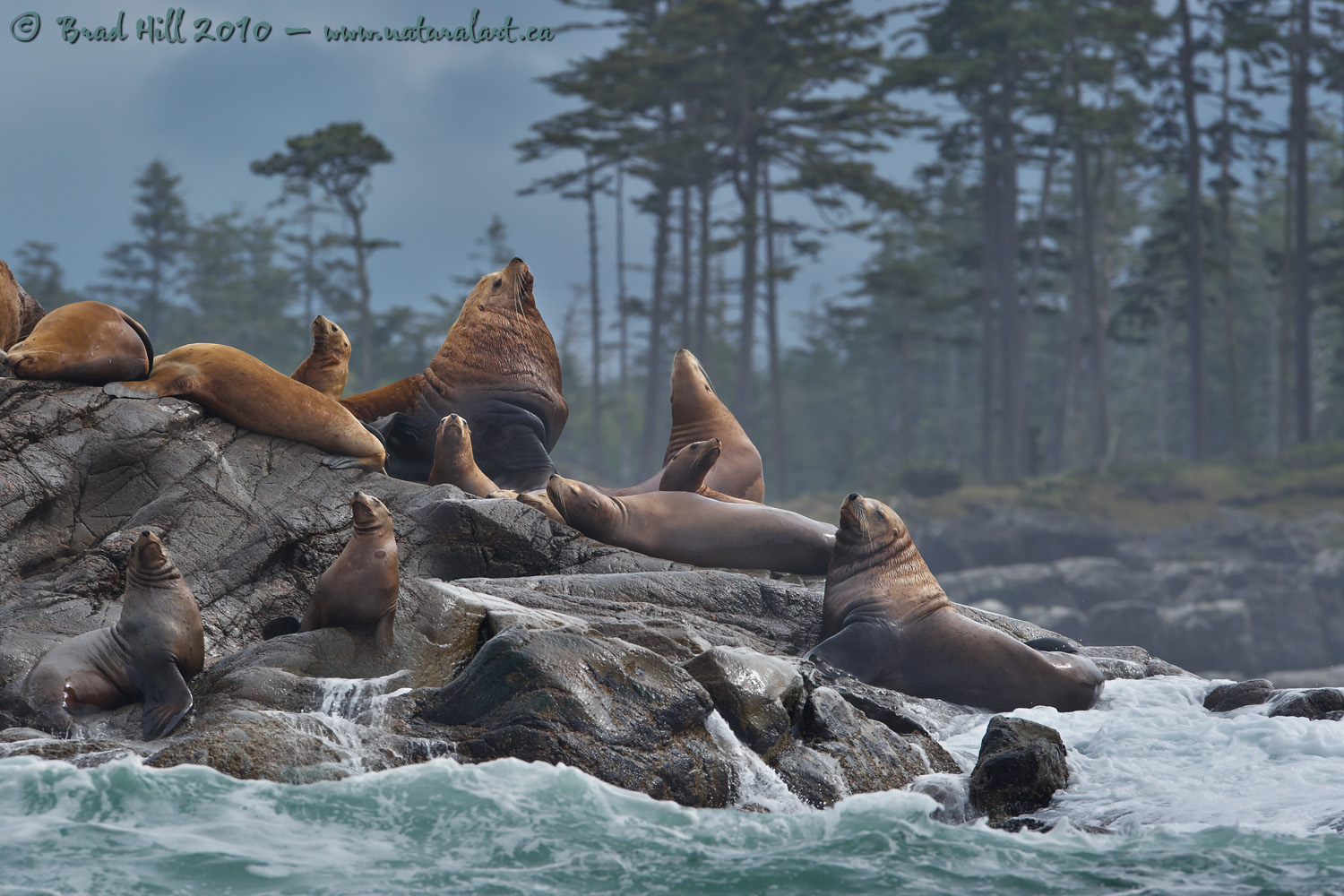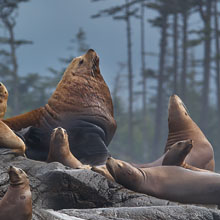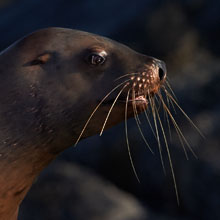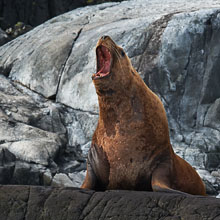Availability: Undetermined - Enquiries?
In the Field
The King's Court. Northern Vancouver Island region, BC, Canada. August 27, 2010.
There's no doubting which of these Steller's Sea-Lions is the "Leader of the Pack" - at least on this rock! This image was captured on a small, relatively remote island just north of the northern tip of Vancouver Island. There were a number of small "haul-out" rocks in the area, and each was absolutely covered in sea lions - in total there had to be 400 or 500 individuals. Interestingly, each rock appeared to have a single male perched atop it who was clearly dominant to the other seals (mostly females or young males) and each was posed in a way that showed he clearly knew he was top dog (like the very rotund male shown here)! Steller's Sea-Lions have a polygynous mating system where males actively defend a territory against other males - which is normally a "prime" piece of rock. Females move freely between the territories of males and will display in a way that solicits the males to continue defending their territories for months on end (and long after the males' own drive to defend the turf and mate has begun to wane). Reproductive success for the males is tied to their ability to defend their turf, and pitched battles WILL occur between nearly equally-matched males to gain and hold those key breeding territories.
While this may appear to be simply an "f8 and be there" shot (i.e., the hardest part of getting it was finding the subjects), both capturing it and processing it was on the tricky side. On the image capture end - this image was shot from a small inflatable boat. At the time of the shot we had both medium-sized swells (between 1-2 meters in size) and wave-induced surface chop to deal with. So...suffice to say that there was NOT a stable platform to shoot from! I was hand-holding a large telephoto lens (a 400mm f2.8) and while I was tempted to shoot wide-open (at f2.8) to maximize the shutter speed, I really wanted all the sea lions and the rocks in sharp focus. So I had to stop the aperture down considerably (to f7.1). And, even with the VR function on the lens helping to stabilize the image, it was absolutely impossible to keep the subjects in the viewfinder as the boat rocked. So I decided to NOT fight the boat and simply went with the rhythmic bobbing of the boat and shot bursts of images as my lens went up and down (and the subjects passed through my viewfinder).
On the processing side...even though this image was shot with a light cloud cover, the brightness range in the image (from the dark regions on the sea lions through to the white foam in the breaking waves) made it impossible to retain critical shadow and highlight detail in a single conversion of the raw file. So I made three raw conversions from the original raw file (one at -1.5 stops for the water in the foreground and the "foam" near the right edge of the image, one at 0 stops adjustment for the rocks and background, and one at +0.5 stops to bring out the shadow detail in the dark portions of the sea lions - especially the big guy near the middle) and then later composited (stacked) them in Photoshop and adjusted the opacity of the layers (via masking) to end up with the final composite image you see here! Of course, along the way I made some selective changes to the contrast as well - I wanted to keep that misty, ocean-spray softened background quite low in contrast while increasing the contrast of the subjects (and rocks) to make them "pop" just a little more. At the end of the day, I kinda like the near 3D affect that these image "tweaks" produced!
Here's a higher resolution (2400 pixel) version of the King and his court:
• The King's Court: Download 2400 pixel image (JPEG: 1.3 MB)
NOTES:
1. This image - in all resolutions - is protected by copyright. I'm fine with personal uses of it (including use as desktop backgrounds or screensavers on your own computer), but unauthorized commercial use of the image is prohibited by law. Thanks in advance for respecting my copyright!
2. Like all wildlife photographs on this website, this image was captured following the strict ethical guidelines described in The Wildlife FIRST! Principles of Photographer Conduct. I encourage all wildlife photographers to always put the welfare of their subjects above the value of their photographs.
3. This image was captured during my "Humpback, Orcas, Sea Lions & More" photo tour in August of 2010. Each year I offer trips into two different parts of the Great Bear Rainforest as well as one to photograph aquatic mammals and oceanscapes near the northern tip of Vancouver Island. And, in selected years, I also offer photo tours to locations to capture other highly sought-after subjects, such as various owl species of the boreal forest and wildlife of Canada's Arctic. Details about these trips can be found on the Photo Tours page of this website.
Behind the Camera
The King's Court. Northern Vancouver Island region, BC, Canada. August 27, 2010.
Digital Capture; RAW 14-bit format; ISO 500.
Nikon D3s with Nikkor 400mm f2.8G VR lens - handheld from Zodiac inflatable boat. VR on and set to "Normal" mode. Circular polarizer used.
1/1600s @ f7.1; no compensation from matrix-metered exposure setting of camera.
At the Computer
The King's Court. Northern Vancouver Island region, BC, Canada. August 27, 2010.
RAW Conversion to 16-bit TIFF, including first-pass/capture sharpening using Phase One's Capture One Pro 5. Three RAW conversions at different exposure settings (one at -1.5 stops for the water in the foreground and the "foam" near the right edge of the image, one at 0 stops adjustment for the rocks and background, and one at +0.5 stops to bring out the shadow detail in the dark portions of the sea lions - especially the big guy near the middle).
Further digital corrections on 16-bit TIFF file using Adobe's Photoshop CS5 and Light Craft's LightZone. Photoshop adjustments included compositing and masking of 3 exposure versions, selective saturation of colours, selective curves adjustment, and selective sharpening for web output. Final tonemapping and contrast/tone tweaking performed with LightZone use the (tonemapper/re-light tool).
Conservation
The King's Court. Northern Vancouver Island region, BC, Canada. August 27, 2010.
Ten percent of the revenue generated by this image will be donated to Raincoast*.
Species Status in Canada**: Special Concern (November 2003) - protected in Canada since 1970.
The Steller's Sea-Lion (Eumetopias jubatus) is the largest of the sea-lions, and males can weigh up to a ton (females are considerably smaller and rarely weigh over 600 lb). Males compete among themselves for females, and successful males end up breeding with several females within their harem.
From the early 1900's through to the 1970's huge numbers of Steller's Sea-Lions were culled for their fur and to remove a competitor (for humans) for salmon. During that time approximately 55,000 sea lions were killed and the breeding population of BC was lowered to about 4,000 animals. Since the Steller Sea Lion first received protection in 1970 the population in the coastal waters of BC has grown to between 18,000 to 19,700 animals (7,600 or so of these are of breeding age).
*The Raincoast Conservation Society (and Foundation) is an effective and efficient organization that has been fighting for protection of this unique habitat. If you are looking for a meaningful way to contribute to the conservation of this amazing ecosystem, Raincoast will provide maximal "bang" for your conservation dollars.
**as determined by COSEWIC: The Committee on the Status of Endangered Wildlife in Canada

























